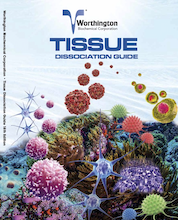For our international customers, please be advised that orders cannot be placed through our website by customers in countries with International Distributor representation.
Worthington Tissue Dissociation Guide
Optimization Techniques: Optimization Strategy
Review the References of the Worthington Tissue Dissociation Guide for the particular tissue and cell type of interest, and then apply this information to the practical application of tissue dissociation. An example of a basic optimization strategy follows:
Based upon the enzyme(s) cited, working concentrations and the buffer or media system used, set up proposed preliminary dissociation conditions similar to the closest available reference(s) listed in the tables.
If a majority of the most similar referenced procedures cite the use of more than one enzyme, optimize the concentration of the primary enzyme (the one at the highest relative concentration) before adding the secondary enzyme(s). For example, if the two most similar references cite collagenase 0.1% with DNase 0.01% and collagenase 0.075% with hyaluronidase 0.025%, optimize the collagenase concentration empirically before evaluating the effects of either the hyaluronidase or the deoxyribonuclease.
After optimizing the primary enzyme's concentration and incubation conditions evaluate any secondary enzyme(s).
Initially vary the concentration of the primary enzyme approximately 50% relative to the referenced procedure(s). The above example of collagenase concentrations 0.1% and 0.075% suggests an evaluation of enzyme concentrations between 0.025% and 0.15%. The concentration increments should be evenly distributed to cover this entire range. As a result incremental concentrations of 0.025%, 0.05%, 0.075%, 0.10%, 0.125% and 0.15% would be indicated. To simplify the initial screening the middle of the range can be selected and, after evaluation of yield and viability results, a decision can be made regarding the need for further studies. In this case initial collagenase concentrations evaluated may be 0.05%, 0.075%, 0.10% and 0.125%.
Historically, most tissue dissociation and cell isolation protocols have cited the enzyme concentration used in terms of weight per unit volume (w/v). More recently, however, some researchers have begun to use the enzymes on an activity basis, that is, units per milliliter (u/ml). Use either method but consider the advantages and disadvantages of each:
a) The traditional weight per unit volume method most likely resulted from the use of cruder, partially purified mixtures of enzymes and is used independently of any specific or contaminating activities which may be present. With some of these crude preparations the lot-to-lot variation can be significant resulting in up to a two-fold difference in the amount of enzymatic activity added on a weight basis.
b) Adding by activity can result in a possible two-fold difference in the amount of weight added to a dissociation; however, normalizes the potency used based upon the primary activity for each lot.
Both methods ignore the relative contaminant activity levels. Upon establishing a basic method, consider pre-sampling different lots of enzyme(s) to evaluate these factors and to select a lot of enzyme which has minimal effect upon the critical parameters of a specific application.
Important: For accurate evaluation of a particular procedure's performance, cell yield and viability should be quantitated and compared. After optimizing basic dissociation and isolation conditions, the specific application parameters such as metabolic function(s) or receptor binding capability should also be evaluated. Based upon these results the method may be judged suitable for use or re-optimized for higher retention of native cellular charactaristics.
Tissue Tables
The Worthington Tissue Tables provide references useful to researchers interested in tissue dissociation and cell harvesting procedures. The references are organized by Tissue and Species type and linked to PubMed citations. The Cell type, Enzymes, and Medium for each reference is provided.
To search by specific criteria, use the Tissue References Search Tool.
